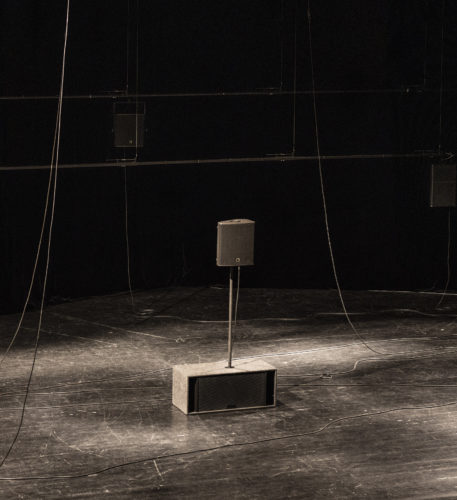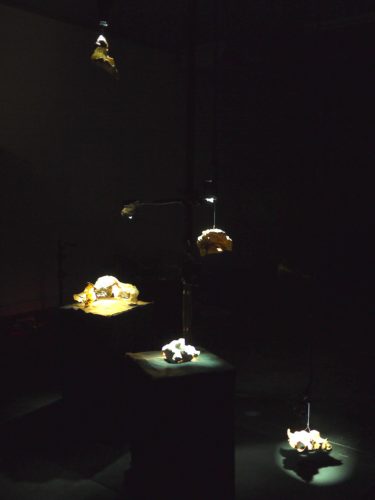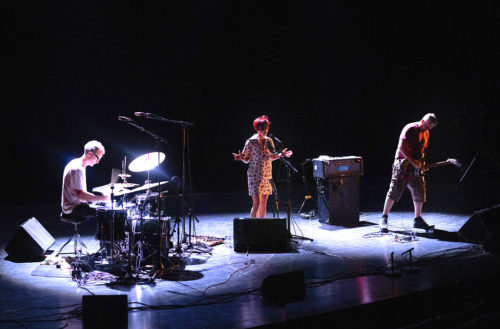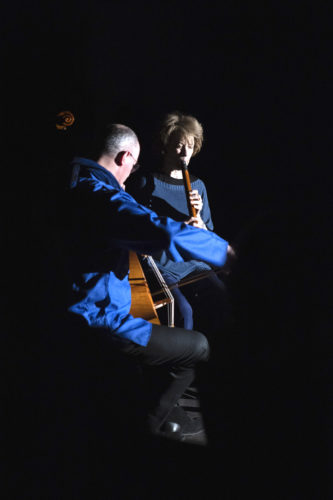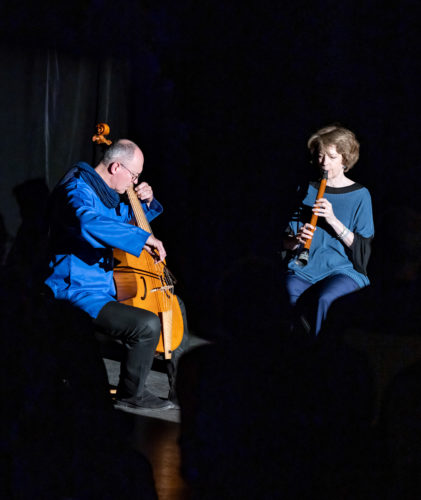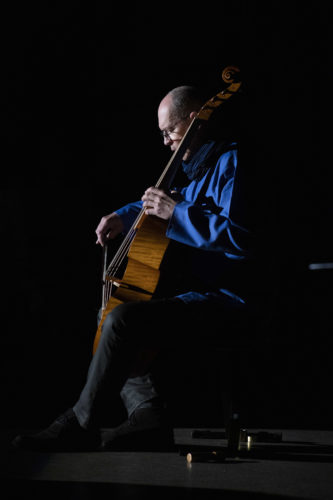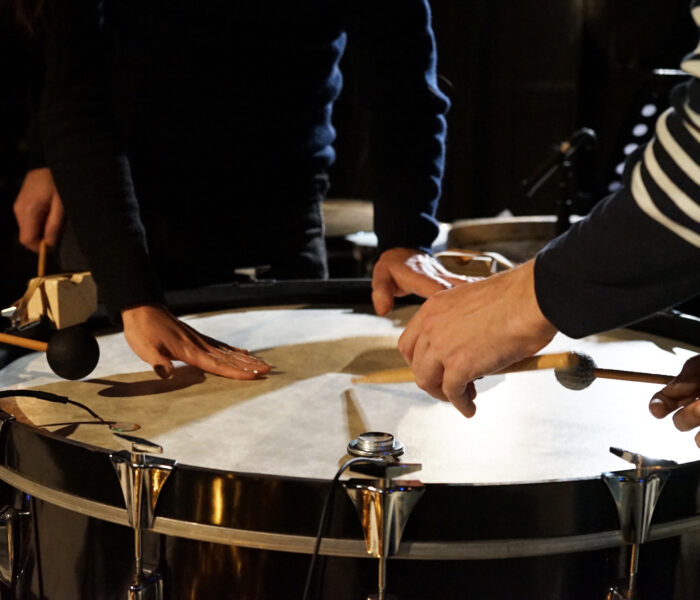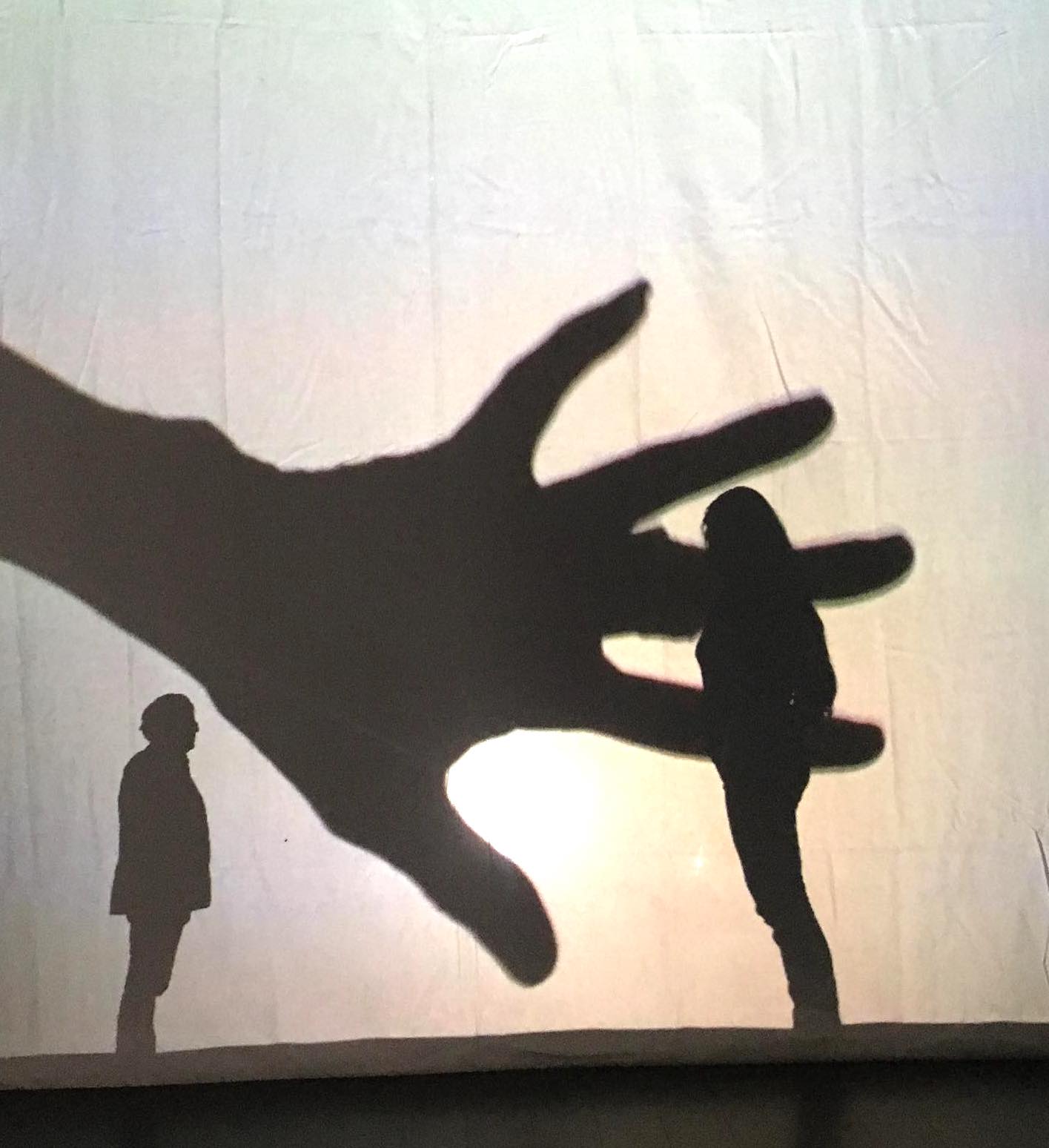A day-by-day account of half a festival in transition. It's all about sound facts and gestures, hidden or revealed, intense and renewed energies.
Fellow travelers
Strangely enough, this was my very first visit to the CCAM, Centre Culture André Malraux in Vandoeuvre-lès-Nancy, and to this festival whose programming I've been following for over twenty years. It was about time. Was it too late? Too late, in any case, to see this year's performance by Fanny de Chaillé and Sarah Murcia around Lou Reed's album Transformer - Transformé, which seems to have won everyone's votes - or Erwan Keravec's Sonneurs, the encounter between Mark Fell and Will Guthrie or that between Wilfried Wendling and Hélène Breschand.
But as soon as I stepped off the train, what a pleasure to find myself immersed in the shadow and machine theater of Pierre Bastien (26/05). For over three decades now, this French musician, who divides his time between the Netherlands and Spain, has been honing an aesthetic universe that is uniquely his own, a world of instruments he invents and assembles himself from Meccano and small motors, machine-like and fragile, modest and demiurgic. His "Mecanium" may have taken on spectacular proportions in the past, but today it's restricted to a derrick-shaped structure to which he adds small mechanisms and other accessories, musical prostheses or not, bows or rubber bands. A music box whose mesmerizing loops - an effect heightened by two small lamps projecting their multiplied shadows onto the wall - form miniature symphonies, rattling and clattering, which become concertos when he grabs his trumpet - itself subject to many original and zany treatments. Much has been written about Pierre Bastien's music, about his art of marrying the raw and the learned. On Thursday May 26, this music, at times reminiscent of an aquatic brass band or the orchestra of a phantom circus, seemed to me to be shrouded in nostalgia, and reminded me of that of the late Philip Jeck - who also excelled at extracting profound musical moments from a seemingly minimalist device (one or two record players, a small keyboard), with the help of a mixing desk and a few effects.
Pierre Bastien, who worked with Jac Berrocal and Pascal Comelade in his early days, is one of Musique Action's regulars, one of those artists with whom the festival has always enjoyed a natural partnership. This is also true of Guigou Chenevierwho appeared the following day in a duet with guitarist guitarist Gilles Laval (27/05). Using an amplified plate and (too?) many accessories, the percussionist delivers a series of brief sequences that are sometimes very seductive (particularly when, towards the end, they venture into ambiences sometimes close to no-wave), but in the long run a little demonstrative and systematic: each piece exploits a new accessory, and a new guitar technique, and this search for the unheard-of sometimes seems to take precedence over the musical discourse. Nonetheless, the whole thing has a very spectacular feel, not so much because of this heterodox instrumentarium as because of the gestures it authorizes and provokes - as much as Laval remains stoic and calm, Chevenier seems nervous, possessed, grasping his tools with sudden movements that evoke those of a painter brushing his canvas with broad strokes...
There was also plenty of gesture in the duo ofeRikm and Jean-Philippe Gross, other Musique Action fellow-travelers, reunited under the alias Ursatz (May 26). Commanding a wide variety of machines, they attack head-on with a very aggressive and noisy set, which at least has the merit of breaking with the age-old crescendo/decrescendo pattern. This roller-coaster ride is fascinating to watch (you wonder who's producing what), and to listen to, as it moves back and forth between sonic abstraction (with certain electronic blasts and other beautiful "concrete" sounds, reinforced by the spatialization) and narrative temptation: However, it's when the latter takes over - with the fleeting appearance of field-recordings (birdsong, water rustling), almost pulsating rhythms, almost melodic layers - that the music produces its most beautiful effect and manages to really move.
Also a regular at the festival and a leading figure in the experimental/improvised scene that is its historical channel, singer and clarinetist Isabelle Duthoit Isabelle Duthoit had received me a few minutes earlier in the dressing room she shared for two afternoons with cartoonist Jean-Marc Troubet, alias Troubsfor a singular moment: for 15 minutes, the duo received one spectator at a time to draw their "sung portrait", he with his brushes, she with her natural voice. A voice about which I've already written extensively elsewhere, and to which I'll return below.
The last of the historical figures featured here, Jérôme Noetinger closed the 38th edition of the festival with Anthony LaguerreMontage is a sound piece which, as its title suggests, is based on sound recordings made during the assembly of a show presented a few months earlier at the CCAM. From this sound material (technicians' voices, the clash of risers and other metal tubes), which they have collected and reassembled, the two musicians have produced a piece of cinema for the ear, which they broadcast from the control room, on an empty stage, populated only by speakers of varying dimensions, and animated by rare variations of light and other curtain movements. The contemplation of this fascinating (non-)set plays no small part in the enduring charm that emanates from this composition, which is both poetic and documentary, revealing what goes on behind the scenes of creation, and bringing to the fore its hidden but indispensable "sides"...
Facts and figures
This dialectic of the occult and the unveiled, of fact and sound gesture, of presence and absence, is at the heart of the MA project presented by the Oxke Fixu duo, formed by clarinettist Xavière Fertin and percussionist Camille Emaille (28/05). I had already had the opportunity to write about the latter, an incredible musician whom I had seen 10 days earlier in Bordeaux accompanying the magnificent and delirious Urs Graf Consort, again thanks to the Einstein On The Beach association. And I was very curious to discover this creation, the day after her touching "sonic encounter" with Guillaume Kosmicki, during which she spoke of her lack of affinity with the outdated habits and customs of the contemporary music milieu from which she comes - and of those ensembles where, before the performance of a piece by Xenakis, "the conductor shakes hands with the first violinist, whereas it's the percussionist who drives the whole orchestra"!
A hybrid project, somewhere between installation and performance, MA - a term which, in Japanese culture, designates "all the subjective variations of emptiness, interval, duration, distance" (I quote from the program) - is apprehended in total, impenetrable darkness, through which the spectator is guided to his seat. The darkness is conducive to leaving the ear free to appreciate the nature of the sounds before it, without being guided by the eye that assigns a particular gesture to a particular sound. Is it percussion (a gong or a bowl rubbed by a bow?) or clarinet, that continuous sound that slowly begins to spread out from silence? Is it percussion or clarinet (a clarinet blowing on a "prepared" cymbal?), that rustling sound that responds from the other side of the room? It's only gradually that we come to grasp the configuration of the room, with the audience forming a circle around a central space occupied by clay sculptures on pedestals, works by Aurore Emaille, which are intermittently illuminated by light; we understand that the two young musicians are standing behind our backs, and that all around us are gongs and other instruments to which transducers are attached, enabling them to vibrate at a distance - the clarinettist becoming a percussionist, and vice-versa. A largely silent piece that ends with the metallic clang of gongs struck with crotales, MA unfolds like a haunting ceremony, a timeless ritual that overwhelms our senses and perception.
The day before, the same questions had already been raised by Phase, a performance-installation designed by David Merloin which a bass guitar placed on a stand, like a pedal steel or keyboard, and violently illuminated by flashes of harsh red or white light, appears to play on its own. In reality, the guitar is looped around itself via a computer system, reprocessing the instrument's sounds and vibrations live, while the instrumentalist, seated in a corner of the room, either pulses or observes. It's an electrifying performance, with a rock sound at times, from which we emerge with a question: what happens to improvisation when the instrument, endowed with an autonomous personality, seems to escape its creator?
Another new face in the Musique Action constellation this year, Melaine Daliberta pianist and composer based in Rennes, where he also teaches at the Conservatoire and presides over the excellent Autres Mesures festival, was given carte blanche for his concert at MJC Lillebonne (May 28): he took advantage of this to play short pieces entrusted to him by musician friends Sylvain Chauveau, Stéphane Garin (two of the founders of Ensemble 0) and Mocke, before performing a miscellany of new compositions and extracts from Shimmeringthe album just released by the Nancy-based label Ici d'Ailleurs, which Guillaume Kosmicki has already mentioned in Hémisphère son all the good he thought of it.
In stark contrast to the wide-ranging algorithmic compositions for which he made his name, these are short pieces that the author describes as "instinctive", and which sound like sketches, miniatures consisting of the repetition of chord progressions or simple melodic motifs that seem to have been snatched from time, like those musical ideas that emerge from silence and that we take pleasure in repeating before letting them return... Heir to the many currents of American minimalism, from Philip Glass to Harold Budd or Peter Garland, Melaine Dalibert has not finished tracing his path in our ears.
The previous day at the same venue, Italian double bassist Dario Calderone 's concert on five strings took on a special dimension with David Merlo's proposal. He played Voyage that never ends, a piece handed down by his master Stefano Scodanibbiothe great Italian double bassist who died just 10 years ago, a friend of Giacinto Scelsi and Terry Riley, and another Musique Action fellow traveler. This "voyage", aptly titled, took us through a wide variety of states and moods: first, a long crescendo, a rapid, pulsating ride from low to high register, where the strings, sometimes rubbed, sometimes struck, gradually let out harmonics and resonances that seem to multiply it, giving birth to a quasi-polyphony ; then a passage in pizzicati, where the musician uses all the percussive potential of his bow to give life to unheard-of sounds; a third part where the bow, this time rubbing the strings, produces a grain that verges on saturation, before returning to the rhythmic side with which the concert began. A thrilling journey beyond the usual, from which the performer emerges dazed and breathless - and the listener with him.
Energy flows
In fact, this edition of Musique Action saw some very singular energies circulating. The rock energy of the trio formed by Isabelle Duthoit, drummer drummer Steve Heather and guitarist Andy Moor together for the first time (27/10). Each time, I'm impressed by the fabulous sound that the latter, with the help of a single pedal, manages to get out of his instrument: dense, fleshy, precise, sometimes powerfully low, sometimes metallic and sharp, it blends ideally with Steve Heather's contrasting playing, which forms the ideal counterpoint. Diving like a siren into this magma of sound, Isabelle Duthoit, sometimes on clarinet, sometimes on voice, imposes a magnetic presence, sometimes reminding me of Blixa Bargeld (Einstürzende Neubauten) or Diamanda Galas. An electrifying concert, which we would have loved to see standing up in a raging pit.
On the contrary, the zen-like energy of American Julius Eastman's play Femenine is a joy to behold. Julius Eastman (26/10), a composer who died prematurely (in 1990, at the age of 50) at the end of a chaotic life, and whose work is only just beginning to emerge from oblivion. Femenine (1974) was the only live recording of the piece. Percussionist Stéphane Garin (of the'Ensemble 0) and saxophonist Julien Pontvianne (of the Aum Grand Ensemble) joined forces to produce this transcription for twelve musicians, recorded last year for the Sub Rosa label. For almost an hour, this long repetitive piece, inflexibly carried by a rhythm of bells and a haunting vibraphone motif, takes on its full dimension on stage. The interplay between the different sections (including Ellen Giacone's voice) is spellbinding, as the melody seems to move from one to the other, immersing the listener in an almost amniotic bath of sounds. Always the same, and at the same time always changing, this music plunges the listener into a meditative trance that we can't tell whether it lasted 10 minutes or 10 hours.
Slow Time Low Freqs byElsa Biston (28/10), another piece which (like Oxxe Fixu's MA and David Merlo's Phase ) is equally at home as a performance or installation. Seated in the middle of an audience invited to relax on cushions, the composer controls a set of transducers connected to various objects (notably large metal drums) and instruments (various percussion instruments, mainly drums and gongs) placed on stands all around the room, into which she diffuses frequencies and sounds (including snatches of Mendelssohn!) that cause them to vibrate. The result is a piece which, behind the appearance of a long drone, on the contrary spares a great subtlety of contrasts and variations. Beyond the spectacular and astonishing aspect of its device, Slow Time Low Freqs above all reveals a remarkably fine sense of dramaturgy that gives the impression of slowing down time, whose beat seems to match that of the frequencies that rub and respond to each other in our ears.

Such a plunge into ourselves was the ideal preparation for one of the highlights of this year's event: the presentation by Louis-Michel Marion (viola da gamba) and Carol Robinson (birbyne, a Lithuanian instrument related to the clarinet) of two parts of Eliane Radigue's monumental "in progress" cycle Occam Ocean, including a premiere for solo viola da gamba. Eliane Radigue's music, static, sprawling and yet so vibrantly organic, is like a breath: the listener's breathing seems to follow, almost naturally, the minute fluctuations of the sound material that the musicians, through patient and demanding work, manage to bring to life. These two pieces, which I hadn't heard before, are no exception to the rule: rather brief, they nevertheless allow for subtle stylistic evolutions, notably in the playing of the viola da gamba which, in both pieces, no longer confines itself to a single note but explores the whole range, starting from the lower register and gradually moving upwards, before returning to its starting point. As always, we emerge from listening to this music happy, soothed, lost and at the same time centered, an experience that remains powerfully beneficial.
David Sanson



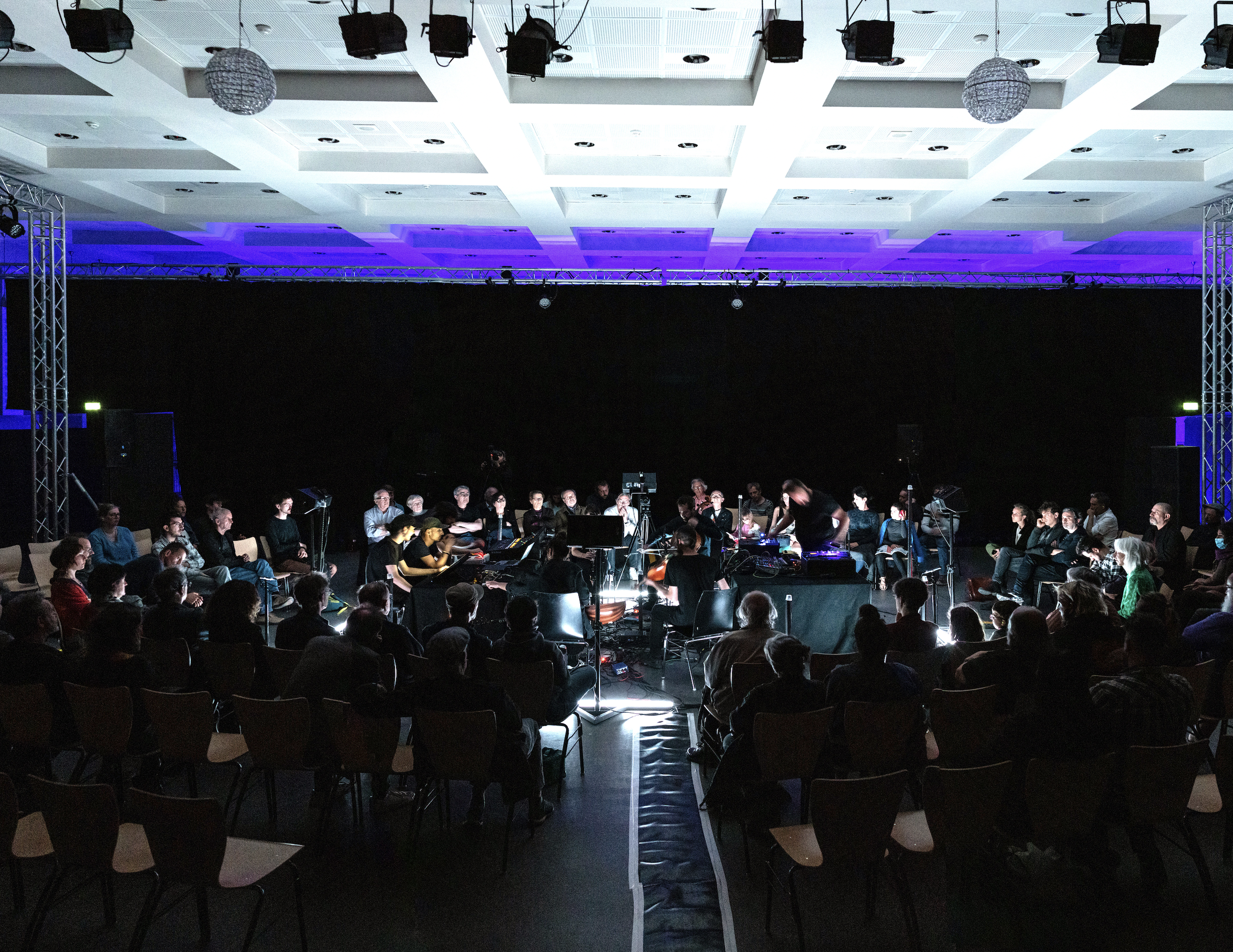)








